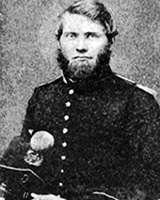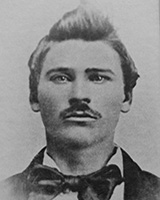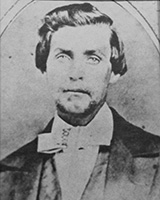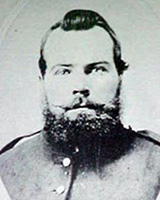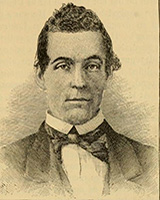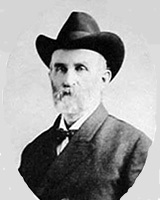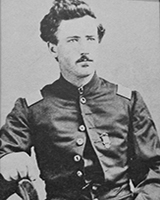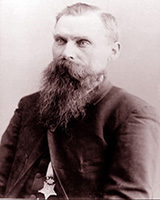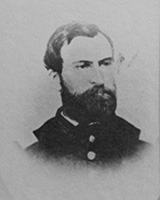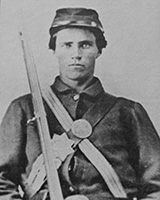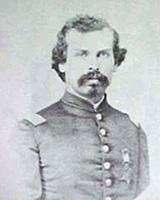National Cemetery Administration
Medal of Honor Recipients: Andrews' Raiders
Great Locomotive Chase: Andrews' Raiders
The Medal of Honor was awarded to 21 of the 24 participants (22 military, 2 civilians) in the Great Locomotive Chase, a daring military mission breaching Confederate lines. Known in history as Andrews' Raiders, 6 of them were the very first to receive the Medal of Honor on March 25, 1863, while 15 others received the medal for the same action later in September 1863, or after the war, or posthumously.
Medal of Honor Recipients
These Veterans are 12 of the 21 Andrews' Raiders who received a Medal of Honor for their actions in the Great Locomotive Chase. Visit their memorial pages to celebrate their legacy, military service and sacrifice to our nation.
Chattanooga National Cemetery
The Raiders who were convicted and hanged, including civilians James J. Andrews and William Campbell, are buried in Section H of Chattanooga National Cemetery, Tennessee.
Samuel Robertson
U.S. Army
PVT
Marion A. Ross
U.S. Army
SGT MAJ
John M. Scott
U.S. Army
SGT
Philip Shadrach
U.S. Army
PVT
Samuel Slavens
U.S. Army
SGT
George Wilson
U.S. Army
PVT
Leavenworth National Cemetery
Lieutenant Daniel A. Dorsey escaped from a prison in Georgia and returned to Union lines in Kentucky. He survived the war and died January 12, 1918. He is buried at Leavenworth National Cemetery, Kansas.
Daniel A. Dorsey
U.S. Army
2ND LT
Private Cemeteries in Ohio
These Raiders are buried at four private cemeteries in Ohio.
William Bensinger
U.S. Army
CAPT
William J. Knight
U.S. Army
PVT
Elihu H. Mason
U.S. Army
1ST LT
John R. Porter
U.S. Army
1ST LT
Mark Wood
U.S. Army
2ND LT
Organizing the Chase
In spring 1862, Confederate forces began the Heartland Offensive by splitting into small groups in an attempt to spread the Union opposition thin. A division from the Army of the Ohio led by Brigadier General Ormsby Mitchel was ordered to Huntsville, Alabama, to repair railroads.
In an effort to capture and control railroads deep into Georgia, black-market trader James J. Andrews developed a plan to conduct small groups of soldiers behind enemy lines. The men were to meet in Georgia, purchase tickets on a train to Chattanooga, overtake the train and destroy telegraph lines, bridges and railroad track along the return trip north. If successful, the raid would render the Confederate supply lines to Chattanooga useless.
The Chase Begins
Andrews began his journey April 7, 1862 with volunteers from three Ohio regiments: 2nd Ohio Infantry, 21st Ohio Infantry, and 22nd Ohio Infantry. The men wore plain clothes and posed as new Confederate army recruits, traveling through military lines to Chattanooga, Tennessee, and then to Marietta, Georgia. Two men were arrested on the trip south, leaving twenty-one men to carry on with the plan.
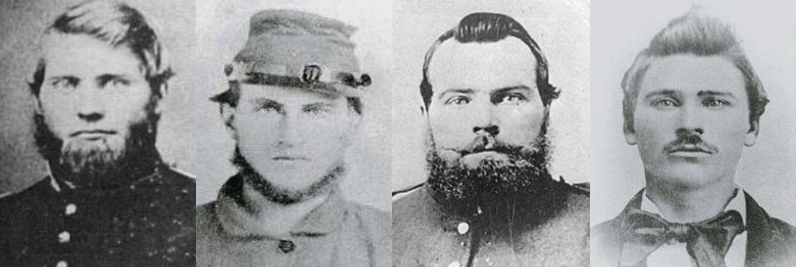 From left to right: Marion Ross, who received the medal posthumously, c.1861. Samuel Roberts, c. 1861. Samuel Slavens, the last Raider to receive the medal in 1883, c.1861. John Scott, who was hanged as a spy for participating in the raid, c. 1860 (Ancestry.com).
From left to right: Marion Ross, who received the medal posthumously, c.1861. Samuel Roberts, c. 1861. Samuel Slavens, the last Raider to receive the medal in 1883, c.1861. John Scott, who was hanged as a spy for participating in the raid, c. 1860 (Ancestry.com).Early on the morning of April 12, 1862 nineteen of the Raiders boarded a northbound train. Two men overslept and missed their train. Upon arriving at the train station in Big Shanty to refuel, the undercover passengers disembarked for breakfast. The stop, near present-day Kennesaw, had no communication lines. There, the Raiders uncoupled the train cars. When the train departed northward, only the locomotive called General, a tender, and three empty boxcars moved forward.
The Confederacy Catches On
Lacking a means of communication with the next station up the line, the Confederate pursuit began on foot. The railroad men, one the train's engineer, ran after the General for two miles. At the next station, two of the chasers commandeered a handcar in order to continue. Eventually, the pursuers obtained a locomotive, switched to a faster one, and picked up a larger crew. Upon discovering the Texas, a southbound train, the pursuers released its cars and chased the General. There was no time to spare, so the Texas followed the General in reverse.
The Raiders Follow the Plan
In spite of their pursuers, the Raiders cut communication lines and tore up track to prevent news from spreading. Realizing that the other train was gaining on them, the Raiders released two box cars to lighten their load and slow the Texas. Near Resaca, Georgia, the Raiders attempted to burn the bridge over the Oostanaula River by igniting the final boxcar. The damp bridge did not burn. With the pursuers hot on their heels and unable to refuel, the General ran out of steam north of Ringgold — less than twenty miles south of Chattanooga.
The Fates of Andrews' Raiders
In all, The Great Locomotive Chase lasted seven hours and traversed 87 miles. Andrews' Raid had no military effect upon the war effort. Cut communication lines and damaged track were quickly repaired.
The Raiders, however, suffered at the hands of the Confederates. All Raiders were captured within a week, including the two who missed the train at Marietta. Eight of the twenty-one captured men were tried as spies and hanged in Atlanta. The eight included James Andrews, executed on June 7, 1862, and six U.S. soldiers and one civilian executed on June 18. The remaining captured men went to prison camps. Six of the Andrews Raiders were released from prison in a prisoner exchange; these men were awarded the Medal of Honor on March 25, 1863. The remaining Raiders escaped from prison.
"One of 19 of 24 men (including two civilians) who, by direction of Gen. Ormsby M. Mitchell, penetrated nearly 200 miles south into enemy territory and captured a railroad train at Big Shanty, Ga., in an attempt to destroy the bridges and track between Chattanooga and Atlanta."
– An excerpt of a citation for one of Andrews' Raiders
Andrews' Raiders at VA National Cemeteries
All eight of the Raiders who had been convicted and hanged, including civilians James J. Andrews and William Campbell, are buried in Section H of Chattanooga National Cemetery, Tennessee:
One Andrews' Raider, Lieutenant Daniel A. Dorsey, escaped from a prison in Georgia and returned to Union lines in Kentucky. He survived the war and died January 12, 1918. He is buried at Leavenworth National Cemetery, Kansas:
The Andrews' Raiders Monument
The Andrews' Raiders Monument, erected by the State of Ohio in 1890, is an unusual memorial installed at the center of Section H at Chattanooga National Cemetery. The granite base and die supports a bronze replica of the General.
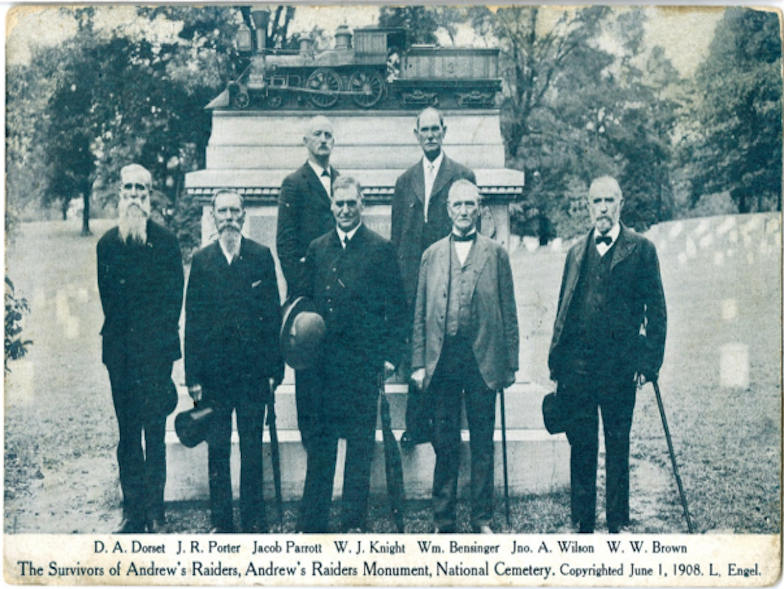 Postcard image of surviving Andrews' Raiders, 1908, posing in front of the Ohio Monument erected to the men and their feat. The postcard mislabels Daniel A. Dorsey as "D.A. Dorset" (NCA Collection).
Postcard image of surviving Andrews' Raiders, 1908, posing in front of the Ohio Monument erected to the men and their feat. The postcard mislabels Daniel A. Dorsey as "D.A. Dorset" (NCA Collection).











